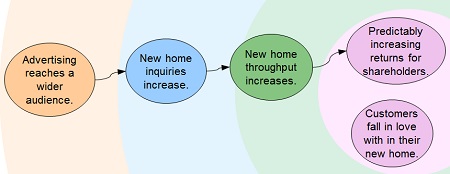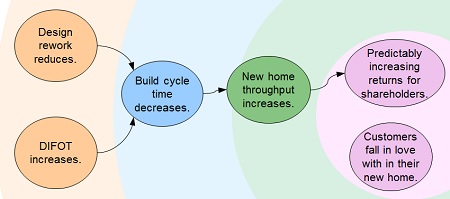2 Ways to Cascade a Measurable Strategy That Creates Alignment
by Stacey Barr |We want everyone in the organisation to align their results to the organisation’s mission, vision and goals. How do you cascade strategy to create alignment? There are two very different ways.

‘Cascading’ is one term often used to describe the way that a corporate strategic direction is broken down into the contributions that each part of the organisation can make, to achieve those overarching strategic goals.
It’s important to cascade a strategy, because people who work from middle-management and below simply find it too hard to link the work under their influence to those high-level strategic goals.
There are two ways to cascade strategy (there may be more, but I haven’t found them yet). The first is the most commonly performed method, to cascade through the organisation’s formal structure. The other way is less known, to cascade through the organisation’s business processes.
Let’s look at each method’s merits and demerits, and how they look in a PuMP Results Map.
METHOD 1: Cascade strategy through the organisation’s structure.
Organisational structure is the way that domains of responsibility are divided up. This is usually done through departments, divisions, business units and teams. There are many names for these parts of structure, and they are used differently around the world. Each part of the structure is headed up by an executive, manager, supervisor or team leader.
Cascading strategy through the organisation’s structure is so common, mostly because of convenience. It’s easy to understand. The command-control chain is clear. Alignment to budgeting is simpler.
The way that strategy is cascaded through the organisation’s structure is a bit like this:
- Each of the highest level of structure, let’s say departments, examines the impact they have on the strategic goals, and they set departmental goals.
- Each division within each department examines the departmental goals, and they set divisional goals.
- Each business unit within each division examines the divisional goals, and they set business unit goals.
- Each team within each business unit examines the business unit goals, and they set team goals.
- Then often, each person within each team examines the team goals, and they set individual goals.
Take the example of a construction company that designs and builds family homes. They have five departments: Sales & Marketing, Finance & HR, Contracting & Design, Projects, and Purchasing.
Imagine the company defines its success, at least in part, by two results: ‘Predictably increasing returns for shareholders’ and ‘Customers fall in love with their new home’. And imagine that it has a strategic goal of ‘New home throughput increases’. A typical structural cascade of a strategic goal such as this, might be as follows:
- The Sales & Marketing Department examines the strategic goal, and sets themselves a goal of ‘New home inquiries increase.’
- The Marketing Division examines this goal, and sets themselves the goal of ‘Advertising reaches a wider audience’.
Their Results Map would then look a bit like this (or a slice of it, anyway):

There are three principle demerits of structural cascading:
Demerit 1: It ignores the white-space or hand-over points across structural boundaries, like between teams, between business units, between divisions and between departments. The risk here is that the Sales & Marketing Department could create more demand than the Contracting & Design team can handle, and the reputation of the company could be damaged. Or worse, lower quality designs could be handed over to Projects to build.
Demerit 2: The cause-effect chain that links team goals through to strategic goals can be too weak. For example, strategy can end up fragmented, and this causes suboptimal performance improvement.
Demerit 3: More change than necessary can occur, where everyone across the organisation is trying to improve something that relates to the strategic goal. More likely though, is that just one or two areas are the real bottlenecks to better performance and all the change energy should go to those bottlenecks.
METHOD 2: Cascade strategy through the organisation’s processes.
Business processes are the flow of tasks and activities, in logical and sequenced order, that deliver services to customers. They are cross-functional, in that they flow across and between and through a myriad of departments, divisions, business units and teams.
Process cascading is great at producing cross-functional alignment and avoiding white space problems and internal competition. The cause-effect chains are stronger because it’s easier to find root causes or bottlenecks holding performance back. And the customer is always in focus.
The way that strategy is cascaded through the organisation’s business processes is a bit like this:
- The main cross-functional core processes of the organisation are identified and mapped.
- Each process team examines the strategic goals, and they set process outcome goals.
- Each sub-process team within each core process examines the process outcome goals, and they set sub-process goals.
Return to the construction company’s strategic goal of ‘New home throughput increases’. Now, look at how strategy could be cascaded through the the core process of the end-to-end client experience:
- The process outcome goal might be ‘Build cycle time decreases.’
- The process flowchart is analysed to find where the bottlenecks or weak links are. Perhaps they find two sub-processes that have bottlenecks: the design approval sub-process has too much rework that holds up contracting; and the procurement sub-process has too many delays.
- The design approval sub-process examines the process outcome goal, and sets the goal of ‘Design rework reduces’.
- The procurement sub-process examines the process outcome goal, and sets the goal of ‘DIFOT increases’. (DIFOT is delivery in full and on time.)
The core process of the end-to-end client experience might produce this slice from the construction company’s Results Map:

There are a couple of demerits for process cascading:
Demerit 1: Few organisations have a business process model, and it is a big effort to build one. The learning curve to build it (properly) as you cascade your strategy can be too overwhelming.
Demerit 2: There isn’t usually one right answer to what an organisation’s process model should look like. So people can be frustrated and worried that they got it all wrong.
Which method is better?
Process cascading is ultimately superior, for sure. Here’s why:
- It removes internal competition over resources and blame.
- It reduces duplication or wasted effort that comes from everyone trying to fix something, without really know if it’s worth fixing.
- It finds where the greatest leverage for improvement lies, and that means the right resources can be given to fixing the biggest bottlenecks that hold performance back.
- The very act of analysing processes to find what the important improvement goals are does, in fact, make finding the right improvement initiatives faster and easier.
And finally, and probably most importantly, process cascading takes the spotlight off people as the bottom denominator of organisational performance, and throws that spotlight onto process design. This sets a climate where collaboration and creativity and continual learning and improvement can flourish.
TAKE ACTION:
How does your organisation cascade strategy? What merits and demerits do you experience in the method you use?
Connect with Stacey
Haven’t found what you’re looking for? Want more information? Fill out the form below and I’ll get in touch with you as soon as possible.
167 Eagle Street,
Brisbane Qld 4000,
Australia
ACN: 129953635
Director: Stacey Barr




